Sarnath, the revered site of Buddha’s first sermon, holds unparalleled significance in the annals of Buddhist history. Here, the enlightened one delivered the seminal Dhammacakkappavattana Sutta, introducing the fundamental teachings that would shape the religion’s core tenets. Today, this hallowed ground draws pilgrims and enthusiasts seeking to enjoy the profound spiritual legacy etched within its archaeological ruins and monuments. From the majestic Dhamek Stupa to the captivating artifacts housed in the Sarnath Museum, the story of Sarnath’s pivotal role in the birth of Buddhism compels visitors to…
Good To Know
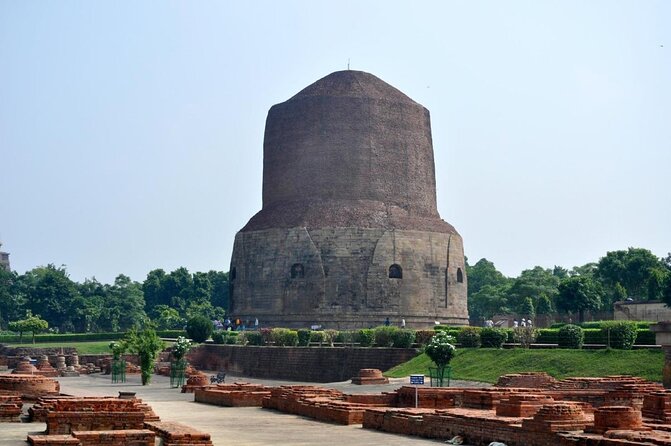
- Sarnath is the site where Buddha delivered his first sermon, known as the "Dhammacakkappavattana Sutta," which marked the hotel of the Buddhist tradition.
- The first sermon introduced the Four Noble Truths and the Eightfold Path, forming the core teachings of Buddhism.
- Sarnath is home to the Dhamek Stupa, a massive monument that stands as a testament to this pivotal moment in Buddhist history.
- The Sarnath Archaeological Museum houses a remarkable collection of artifacts and inscriptions that provide insights into Buddha’s life and the spread of Buddhism.
- Visitors to Sarnath can engage in spiritual practices, such as meditation and circumambulation, at the site’s various stupas and monasteries.
Historical Significance of Sarnath
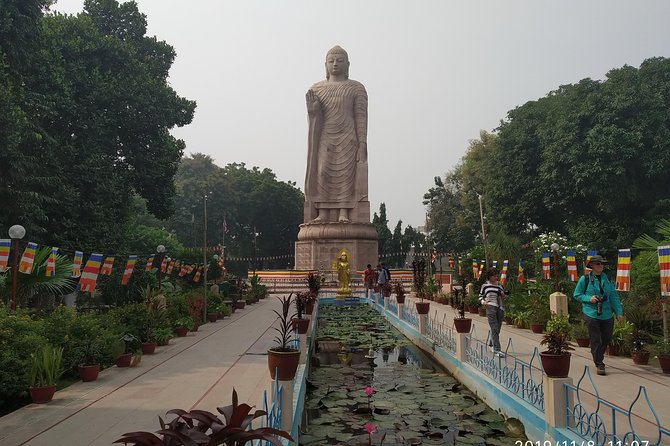
Sarnath’s historical significance stems from its role as the site of the Buddha’s first sermon, where he delivered the teachings that would form the foundation of Buddhism.
After attaining enlightenment in Bodh Gaya, the Buddha traveled to Sarnath to share his insights with five ascetics.
In this sacred location, he expounded the Four Noble Truths and the Eightfold Path, which outline the path to liberation from suffering.
Sarnath thus holds immense spiritual importance as the birthplace of the Buddha’s teachings.
Today, it attracts pilgrims from around the world who come to visit the archaeological ruins and temples that mark this hallowed ground.
You can also read our reviews of more tours and experiences in Varanasi.
The First Sermon of Buddha
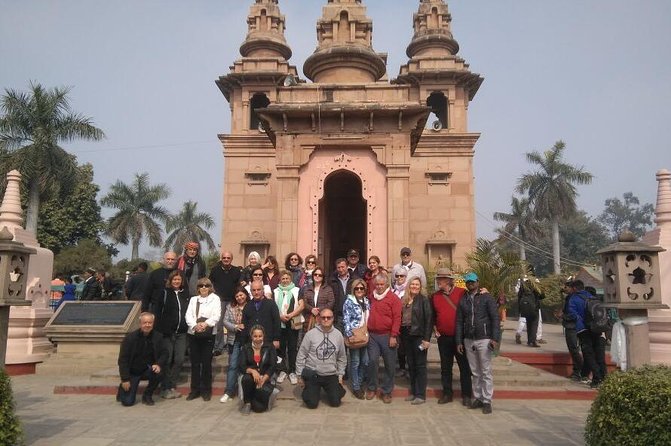
After attaining enlightenment in Bodh Gaya, the Buddha traveled to Sarnath to deliver his first sermon to a group of five ascetics.
This sermon, known as the "Dhammacakkappavattana Sutta," or the "Setting in Motion the Wheel of Dharma," is considered one of the most significant events in Buddhist history.
In it, the Buddha expounded the Four Noble Truths and the Eightfold Path, which form the core of Buddhist teachings.
This first sermon marked the beginning of the Buddhist tradition and the hotel of the Sangha, the community of Buddhist practitioners.
Sarnath thus holds immense spiritual significance as the site where the Buddha’s teachings were first shared with the world.
Architectural Highlights of Sarnath
Several architectural wonders can be found within the sacred grounds of Sarnath. The Dhamek Stupa, a massive stone monument, is the most prominent feature, standing at an impressive height of 43.6 meters.
The Ashoka Pillar, a sandstone column erected by Emperor Ashoka, is another iconic landmark, with its intricate carvings and inscriptions.
The Mulagandhakuti Vihara, a Buddhist monastery, showcases the remnants of the Buddha’s living quarters.
Plus, the Sarnath Archaeological Museum houses a remarkable collection of artifacts, including the famous Ashokan Lion Capital, which has become the national emblem of India.
These architectural marvels provide a tangible link to the site’s profound spiritual significance.
Sarnath Museum and Artifacts
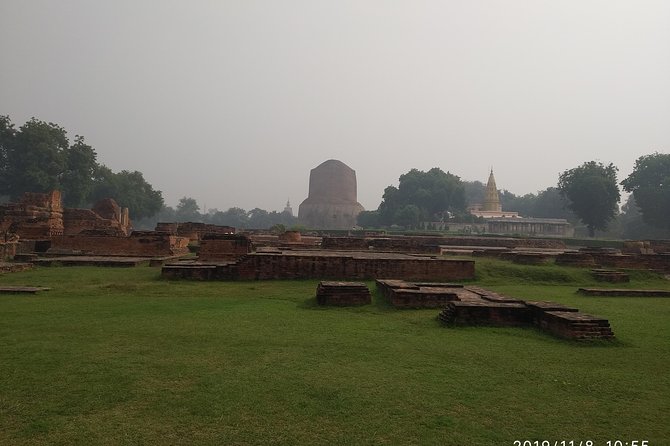
Within the confines of the Sarnath Archaeological Museum lies an extraordinary trove of artifacts that offer a captivating glimpse into the region’s rich Buddhist heritage.
Visitors can explore:
- Exquisite sculptures and statues, including the iconic Lion Capital of Ashoka, a masterpiece of ancient Indian art.
- Inscribed pillars and stone carvings, providing invaluable insights into the teachings and life of the Buddha.
- A remarkable collection of Buddhist manuscripts and scriptures, preserving the wisdom of this ancient spiritual tradition.
- Intricately crafted relics and devotional objects, reflecting the profound devotion of the region’s Buddhist faithful.
These remarkable artifacts offer a window into the past, illuminating the enduring influence of Buddhism in Sarnath and the Indian subcontinent.
Spiritual Practices at Sarnath
Spiritual practices permeate the very fabric of Sarnath, where pilgrims and devotees gather to enjoy the teachings of the Buddha.
At the Dhamekh Stupa, visitors meditate and perform prostrations, honoring the site where the Buddha delivered his first sermon.
The Mulagandhakuti Vihara, the restored remains of the Buddha’s hut, is a hub for chanting, rituals, and prayer.
Devotees light lamps, offer flowers, and circumambulate the sacred spaces, seeking spiritual enlightenment.
The Dharmarajka Stupa, believed to contain the Buddha’s relics, is a focal point for reverential circumambulation.
Through these timeless practices, the essence of the Buddha’s message is kept alive in Sarnath, a testament to the enduring power of his teachings.
Visiting Sarnath: Tips and Insights
Visiting Sarnath offers a captivating experience that goes beyond the spiritual practices observed at this sacred site.
Pilgrims can explore the historical ruins, visit the museum, and marvel at the iconic Dhamekha Stupa, where the Buddha delivered his first sermon.
The tour includes:
- Private transfers from Varanasi to ensure a hassle-free journey.
- Admission to the museum and ruins, providing an in-depth understanding of Sarnath’s rich history.
- A knowledgeable guide who offers insights into the site’s significance and cultural traditions.
- Flexible scheduling and accessibility options, making the tour suitable for a wide range of visitors.
Whether seeking spiritual enlightenment or historical exploration, Sarnath captivates the senses and leaves a lasting impression.
Nearby Attractions and Excursions
While Sarnath is renowned for its spiritual significance, visitors can also explore a variety of nearby attractions and excursions that offer a well-rounded experience.
Just a short distance from the sacred Buddhist site lies the holy city of Varanasi, known for its intricate temples, lively ghats, and vibrant cultural heritage. Travelers can take a boat ride along the Ganges River, witness the captivating Aarti ceremony, or venture into the maze-like alleys to discover local crafts and cuisine.
Plus, the nearby town of Sarnath offers the opportunity to visit the Dhamek Stupa, an impressive ancient monument that marks the location of the Buddha’s first sermon.
These complementary experiences allow visitors to enjoy the rich history and spiritual essence of the region.
Practical Information for Sarnath Tour
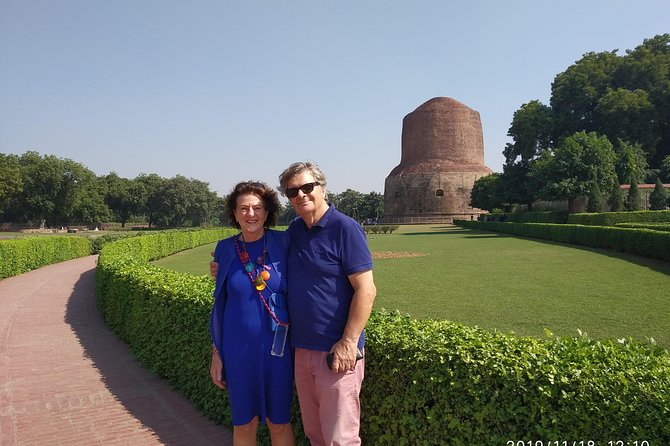
For travelers interested in exploring the sacred site of Sarnath, there are a few practical considerations to keep in mind. The private tour includes museum and ruin entry fees, round-trip transfers from Varanasi, and a 2-hour itinerary covering the ruins, museum, and main temple.
Key details include:
- Pickup points available, with a start time of 9:30 AM.
- Wheelchair accessible and near public transportation.
- Free cancellation up to 24 hours before the experience.
- Tour prices start from $44.71, with a lowest price guarantee and flexible payment options.
With these essential logistics in place, visitors can focus on seeing the rich history and spiritual significance of Sarnath.
Frequently Asked Questions
How Accessible Is Sarnath for Visitors With Disabilities?
Sarnath is wheelchair-accessible and near public transportation, making it accessible for visitors with disabilities. The tour provider offers round-trip transfers and tailors the experience to accommodate individual needs, ensuring an inclusive and enjoyable visit.
Is It Possible to Combine the Sarnath Tour With a Visit to Varanasi?
Yes, it’s possible to combine the Sarnath tour with a visit to Varanasi. The tour provider offers round-trip transfers from Varanasi, making it convenient for travelers to explore both the sacred Buddhist site and the holy city.
What Are the Best Times of Year to Visit Sarnath?
The best times to visit Sarnath are during the cooler months of October to March when the weather is pleasant. Crowds are smaller, and visitors can fully appreciate the sacred Buddhist sites without the summer heat.
Are There Any Dress Code Requirements for Visiting Sarnath?
There’s no strict dress code for visiting Sarnath, but visitors are advised to dress modestly. Loose, comfortable clothing that covers the shoulders and knees is generally appropriate out of respect for the site’s religious significance.
Can Visitors Make Donations at the Sarnath Temples and Monuments?
Visitors can make donations at the Sarnath temples and monuments. Donations are voluntary and can be made at the entrance or shrines. The funds help maintain the historic site and support its ongoing preservation.
Sum Up
Sarnath’s historical significance as the site of Buddha’s first sermon continues to draw pilgrims and visitors. The Dhamek Stupa, archaeological ruins, and the Sarnath Museum offer insights into this pivotal moment in Buddhist history. Visitors can connect with Sarnath’s spiritual legacy through meditation and exploration of the site’s sacred spaces. Sarnath’s enduring legacy makes it an essential destination for those seeking to deepen their understanding of Buddhism’s origins and teachings.
More Tour Reviews in Varanasi
Not for you? Here's more things to do in Varanasi we have recnetly reviewed
- 20 Best 2 Day Tours In Varanasi
- 20 Best 3 Day Tours In Varanasi
- 25 Best Cruises And Boat Tours In Varanasi
- 6 Best Food Tours In Varanasi
- 15 Best Full-Day Tours In Varanasi
- 2 Best 4 Day Tours In Varanasi
- 7 Best Photography Experiences In Varanasi
- 8 Best Dining Experiences In Varanasi
- 8 Best Dinner Tours In Varanasi
- Varanasi: Ganga Arti Evening Light Ceremony on the Main Ghat
- Learn to Play a Traditional Indian Instrument in Varanasi!
- Day Trip of Haridwar and Rishikesh From Delhi By Car
